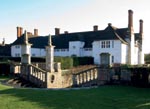Marshcourt, Hampshire
A Tudor-style Lutyens house, enhanced by an imaginative colour theme


Since 1897, when Country Life was founded, the magazine has championed the cause of the architect Sir Edwin Lutyens and his alter ego Gertrude Jekyll, and woe betide any owner of a Lutyens house who dared to alter it in a manner deemed inappropriate. 'All White is not All Right' thundered Clive Aslet in the 1980s, when the American billionaire owner of Deanery Garden at Sonning-on-Thames, Berk-shire, decided to liven up the interior by painting Lutyens' trademark oak panelling a brilliant shade of white. In the case of Lutyens' iconic, Grade I-listed, Tudor style Marshcourt at Stockbridge, Hampshire for sale through Knight Frank (01962 850333) at a guide price of 'excess £13 million' all white was considered quite all right, and successive editors (September 16, 1906; April 19, 1913; March 19, March 26 and April 2, 1932) enthused over the architect's inspirational use of the gleaming local white chalk, or clunch, as the main building material for the house. Previously, clunch had been used inside churches and for cottages, but never as the building material for a 27,000sq ft country house, where the whiteness of the walls is enhanced by the contrast with the tall, red brick chimneys and long, unbroken sweeps of pitched tile roof. The current vendors will no doubt be relieved to hear that Country Life's architectural editor, Jeremy Musson, who visited Marshcourt last year, was favourably impressed by the way in which Lutyens' all white theme has been expanded throughout the interior to create an exciting, 21st-century country house against the background of an Edwardian Arcadia. Marshcourt stands on a chalk outcrop overlooking the Test Valley on the edge of Stockbridge, and was built between 1901 and 1904 for Lutyens' friend Herbert Johnson an 'adventurer, stockjobber and sportsman', who made and lost a fortune in the City, before making another. The house was completed in 1904, but Lutyens came back several times over the years to make alterations and improvements installing more bathrooms and adding, in 1924?26, the Great Hall, or ballroom to the south-east corner of the house. The gardens at Marshcourt described in Country Life (March 19, 1932) as 'one of the most fully worked out garden schemes with which the names of Lutyens and Gertrude Jekyll are associated' were designed in a series of terraces to take advantage of the natural fall of the ground. Formal elements, such as the 'rendezvous lawn', the Grade II*-listed sunken garden and the pergola with its adjacent stone pools, are offset by large sweeping areas of lawn. Seeing Marshcourt today in all its splendour, it is hard to imagine that, for 40 years, this was a boys' prep school, before Labour MP Geoffrey Robinson bought the property in the 1980s. They must have been a well behaved little bunch, as even Lutyens' original billiard table has survived unscathed. Mr Robinson apparently spent little time at Marshcourt, and, eight years ago, he sold it to the present owners, who have worked wonders, not only with the grand Edwardian rooms the spectacular drawing room, dining room, library and ballroom but upstairs as well. Marshcourt has six bedroom suites, plus four more bedrooms, two more bathrooms and a staff flat. As well as the lovely Jekyll gardens, Marshcourt's 47 acres of grounds include two lodges, estate offices, woodland, paddocks and the newly restored tennis court.
Sign up for the Country Life Newsletter
Exquisite houses, the beauty of Nature, and how to get the most from your life, straight to your inbox.
Country Life is unlike any other magazine: the only glossy weekly on the newsstand and the only magazine that has been guest-edited by HRH The King not once, but twice. It is a celebration of modern rural life and all its diverse joys and pleasures — that was first published in Queen Victoria's Diamond Jubilee year. Our eclectic mixture of witty and informative content — from the most up-to-date property news and commentary and a coveted glimpse inside some of the UK's best houses and gardens, to gardening, the arts and interior design, written by experts in their field — still cannot be found in print or online, anywhere else.
-
 Two quick and easy seasonal asparagus recipes to try this Easter Weekend
Two quick and easy seasonal asparagus recipes to try this Easter WeekendAsparagus has royal roots — it was once a favourite of Madame de Pompadour.
By Melanie Johnson
-
 Sip tea and laugh at your neighbours in this seaside Norfolk home with a watchtower
Sip tea and laugh at your neighbours in this seaside Norfolk home with a watchtowerOn Cliff Hill in Gorleston, one home is taller than all the others. It could be yours.
By James Fisher